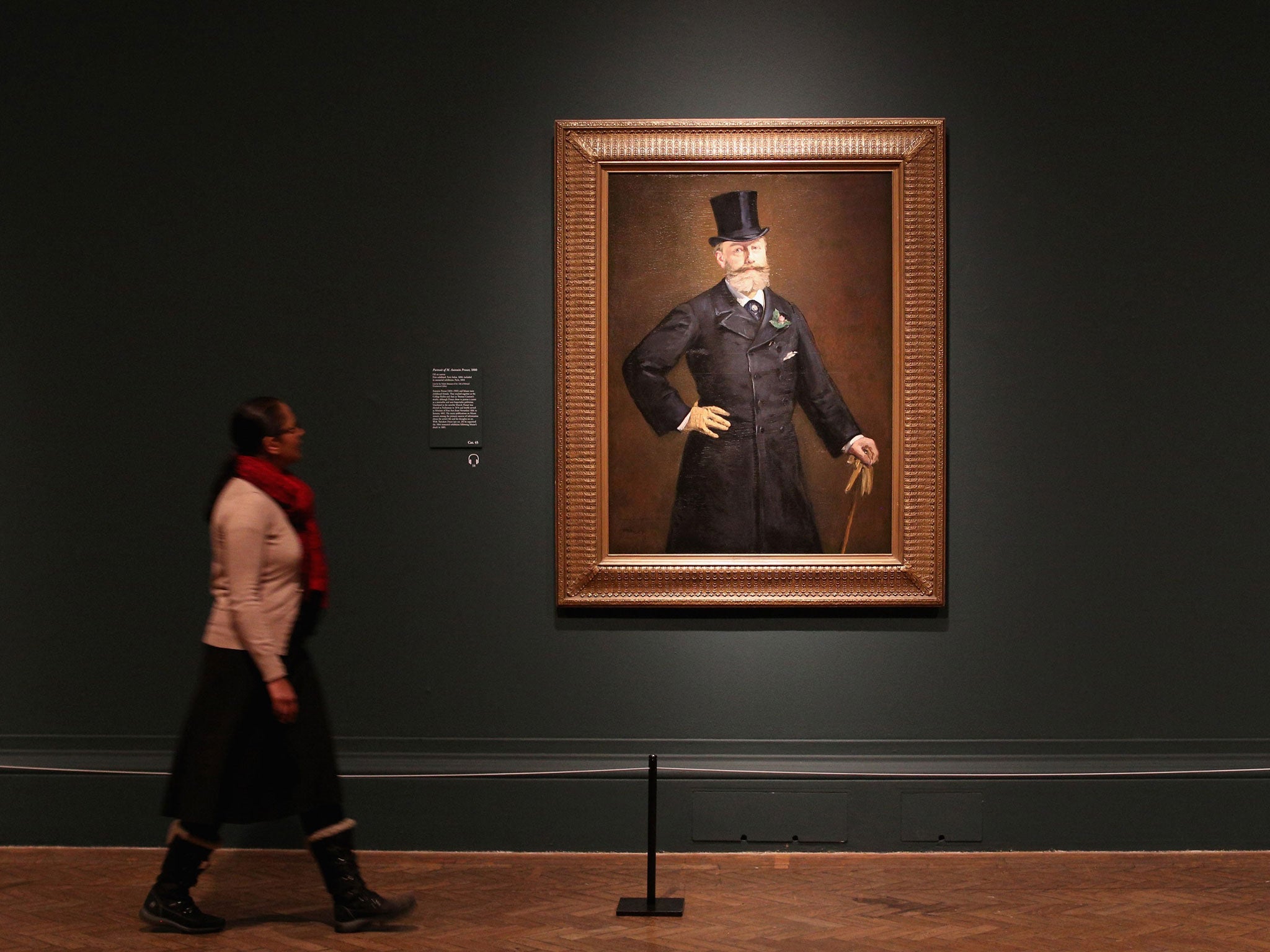Visual art review: Manet has to go a little further nowadays
A sparingly hung exhibition of portraits has lumpen duds among the star turns – for comparison, or because that's all the RA could get hold of?

Like many of Manet's paintings – like his work as a whole – The Railway is a game of two halves. To the left of the picture is a woman with one of those pouty French mouths, shaped by generations of going pffffft. She is Victorine Meurent, Manet's favourite model. Next to her, back view, is a child in a white dress and blue sash. She is sometimes identified as the daughter of Manet's friend, Alphonse Hirsch, although, since we cannot see her face, her identity is neither here nor there. She exists as a foil to Victorine.
Mesmerised by the steam of the train beyond the iron railings, the little girl stands for lost innocence. Victorine, modern to the core, turns her back on this marvel – the line running into the Gare Saint-Lazare – fixing us instead with the direct gaze of a shopper at one of the new grands magasins; or, perhaps, of something for sale.
So far, so binary. It isn't just The Railway's composition that is split, but the work's technique. Victorine is painted in a style that mingles Impressionist rapidity with Manet's admiration for the Spanish masters. The little girl, though, is oddly clumsy – out-of-scale, impossibly twisted, her left arm as lifeless as a shop dummy's. Since Manet lets us know, via Victorine, that he can paint like Velazquez when he wants to, we have to assume that this isn't an accident – that he means the child to be clumsy, which is to say childlike.
It's a possibility to carry in your head as you walk around the Royal Academy's new exhibition, Manet: Portraying Life. Among the many wonders of this show are a surprising number of works that are just not very good. The question you might want to ask yourself is: did Manet mean them to be?
Let's start with a wall in Room Four. Here are three portraits of Manet's sister-in-law, the artist Berthe Morisot, and two of his student, the painter Eva Gonzalès. The former are extraordinary. Berthe Morisot in Mourning, made in 1874 after the death of the sitter's father and before her marriage to Manet's brother, Eugène, is among the most radical portraits of the 19th century. Morisot's face is rendered as a mess of painted gashes, its composition on the point of falling apart as, presumably, was Morisot herself. But Gonzalès … can the hand that painted the grieving Morisot so masterfully really be responsible for the two dreadful portraits of her in this show?
Even allowing for Manet's playing 18th-century games, the pastel Portrait of Eva Gonzalès is lumpish, sentimental and cack-handed. His painted portrait of Gonzalès is scarcely better, her overworked head looking like one of those fairground games where visitors poke their faces through holes in images of strongmen or fat ladies. Are Manet's portraits of Gonzalès bad on purpose, like the child in The Railway, or are they just bad? And, if the latter, what are they doing in this show?
There are two answers to this second question. All great painters experiment, and some of their experiments fail. If the curators of Manet: Portraying Life have included duds to make that point, then they deserve our thanks, historically if not aesthetically. Even if we take this optimistic view, though, the balance of good and bad work in the exhibition does Manet no favours. For every fissile Portrait of Georges Clemenceau there is a boardroom one of Antonin Proust, for every flickering Isabelle Lemonnier with a Muff an embarrassing Emilie Ambre as Carmen. Hanging Berthe Morisot and Eva Gonzalès on the same wall makes you wonder if truthfulness can be taken too far.
A less charitable explanation of why the RA's curators have included so many poor Manets in this show is that they had an awful lot of space to fill and took what they could get to fill it. Many of the works are not portraits at all, but those paintings of everyday life prescribed by Manet's friend, Baudelaire. Just because a picture has a figure in it doesn't make it portraiture. If you broaden your definition of the genre to include all figure painting, then you also broaden visitors' expectations of what they're going to see. So where is Olympe, where Maximilian?
And why, if not to fill space, is Manet's first proper Baudelairean work, Music in the Tuileries Gardens, given a vast room to itself? Sit on the distant bench provided and you would need the eyes of Superman to make out the faces in Manet's crowd – his brother Eugène, Jacques Offenbach, the sulphurous Charles Baudelaire. In any case, you can see them for free in the National Gallery.
I know: carp, carp. This show is, after all, full of astonishment and by definition unmissable. But do be prepared to see a different Manet from the one you've known and loved.
To 14 Apr (020-7300 8000)
Critic's Choice
Gerard Byrne's photography and film works come together for a substantial retrospective at London's Whitechapel Gallery – head downstairs for a series of absurdist short films dramatising real conversations between cultural figures, from Surrealist artists to sci-fi writers (till 8 Mar). Last chance to see Barbara Hepworth's The Hospital Drawings at The Hepworth Wakefield. The abstract artist's drawings and paintings of surgeons at work are on view for a final week (till 3 Feb).
Join our commenting forum
Join thought-provoking conversations, follow other Independent readers and see their replies
Comments